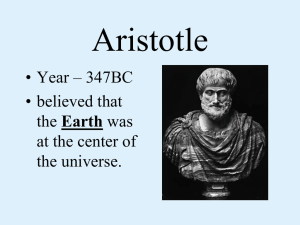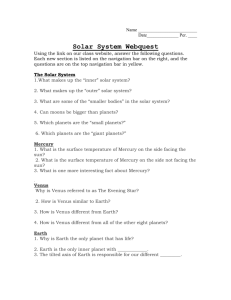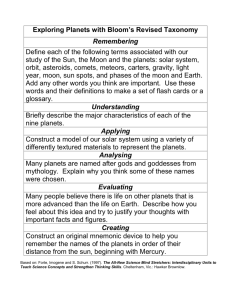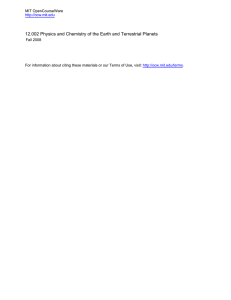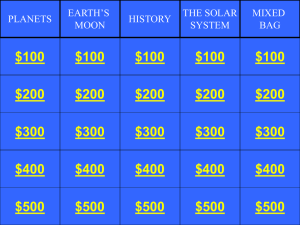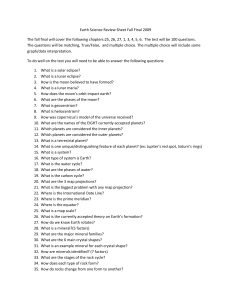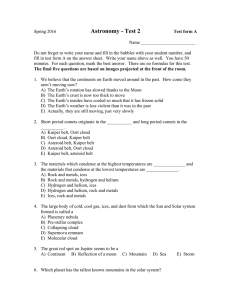the solar system
advertisement
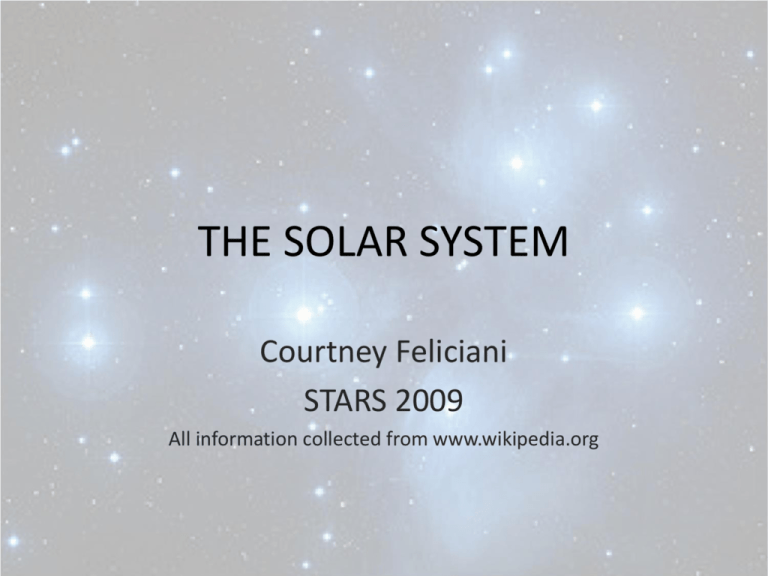
THE SOLAR SYSTEM Courtney Feliciani STARS 2009 All information collected from www.wikipedia.org What is the Solar System? • Made up of the sun, the planets, the moons, asteroids, comets, interplanetary dust, and meteoroids. THE SOLAR SYSTEM THE SUN • The central star of the Solar System. • Its mass is over 300,000 x that of Earth. • Releases energy that radiates through the Solar System. ROTATION • When an object spins on its axis. • Example: an Earth day is the time it takes for the Earth to finish one rotation on its axis. Image from physicalgeography.net REVOLUTION • When an object completes an orbit. • The planets revolve around the sun, and the moon revolves around Earth. • One revolution of the Earth around the sun is one year. Image from education.arm.gov PLANETS • Rounded bodies that orbit a star. • Have their own orbit. • Dwarf planets revolve around a star, but do not have their own orbit. MERCURY • Named for the Roman god Mercury, the messenger god, and the god of trade. • 1 day on Mercury is 176 Earth days. • 1 year on Mercury is 88 Earth days. • Looks like the moon. VENUS • Named after the Roman goddess of love. • 1 day on Venus is 243 Earth days. • 1 year on Venus is 225 Earth days. • The temperature of Venus is the same during the day and night. EARTH • The largest of the first 4 planets, the ‘terrestrial planets’. • Has 1 moon. MARS • Named after the Roman god of war. • 1 day on Mars is 40 minutes longer than a day on Earth. • 1 year on Mars is 687 Earth days. • There is water on Mars. The poles are covered in ice. JUPITER • Named after the Roman king of the gods. • 1 day on Jupiter is about 10 hours. • 1 year on Jupiter is almost 12 Earth years. • The surface is gas. • The Great Red Spot is a storm 3 times the size of the Earth. SATURN • Named after the god Saturnus, who was the god of agriculture. • 1 day on Saturn is about 10 hours, and 1 year is almost 30 Earth years. • Saturn is flattened, meaning that it has a bulge around the equator. URANUS • • • • Named after the Greek god of the sky. 1 day on Uranus is 17 hours. 1 year on Uranus is 84 Earth years. Uranus has 13 rings, some blue and some red. NEPTUNE • Named after the Roman god of the sea. • 1 day is 16 hours, and 1 year is 165 Earth years. • On July 12, 2011, Neptune will complete its first orbit since it was discovered. DWARF PLANETS • The dwarf planets are Pluto, Ceres, Makemake, Haumea, and Eris. • No space probes have been to any of these planets. THE MOON • Orbits around the Earth every 27 days. • The same side of the moon always faces the sun. • Ocean tides are caused by the gravity of the moon acting on the water. ASTEROID BELT • In between Mars and Jupiter • Asteroids are rocks that orbit the sun. • Total mass of the belt is thought to be 1/1000 the mass of Earth. THE KUIPER BELT • Located past Neptune, and is composed mainly of ice • Pluto, Haumea, and Makemake are all located in the Kuiper belt.
